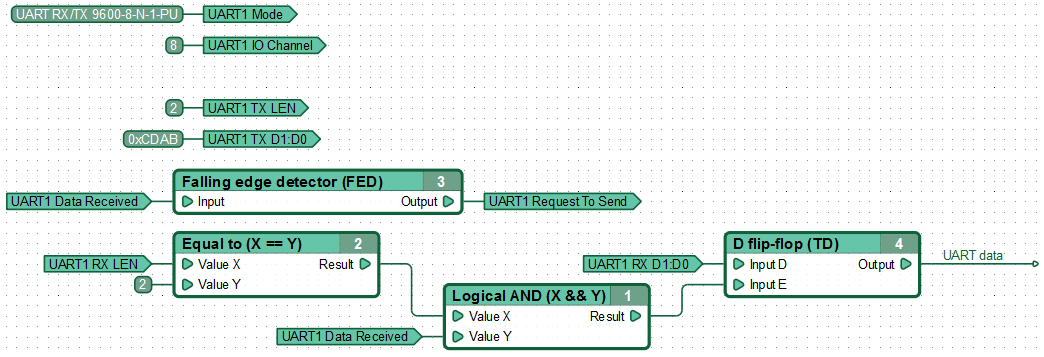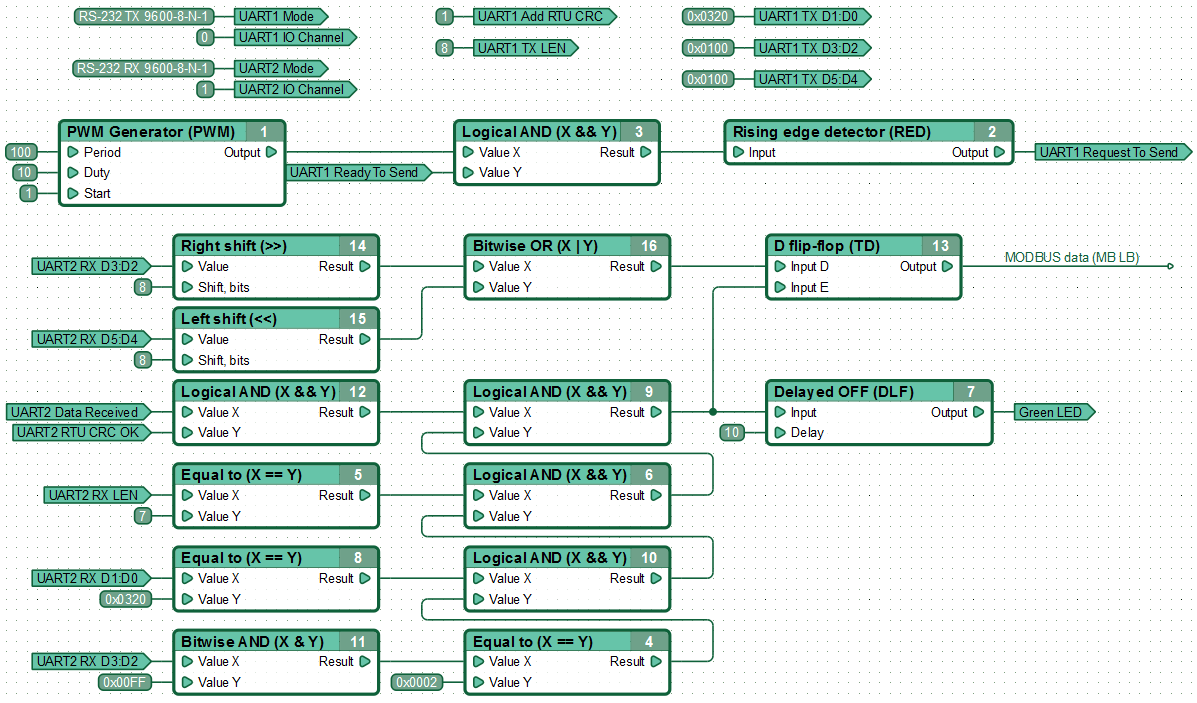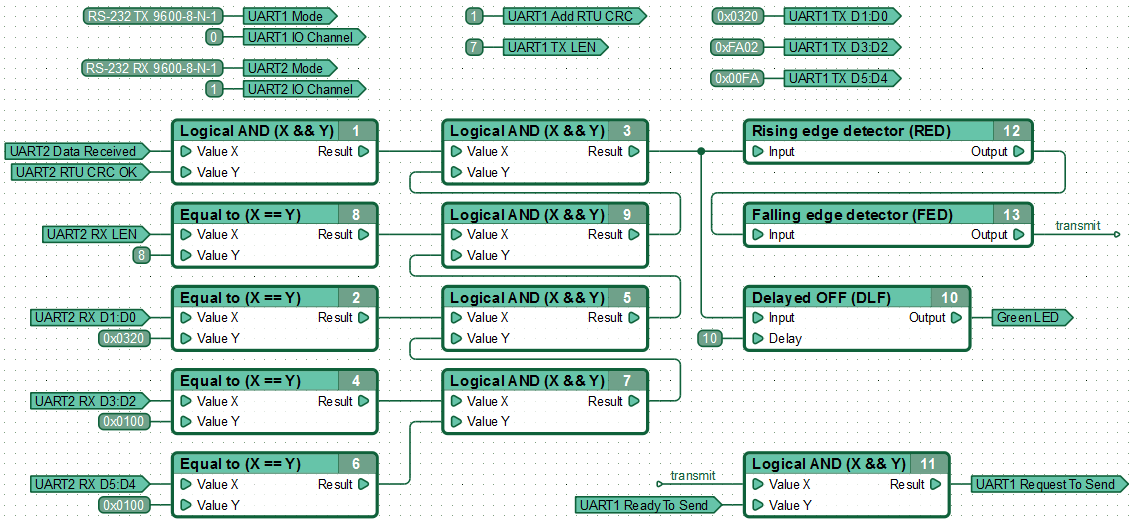| This documentation is out of date.
The new version of the documentation is here: https://cannylogic.com/docs |
CANNY 7.2 duo, UART Driver
Contents
General description
At the same time, up to four of the nine CANNY 7.2 duo input-output channels can be used to organize UART, RS-232 serial protocols data transmission/reception. It may be used to connect the controllers with each other or with external equipment supporting this communications protocols. The channels may be activated independently of each other and have individual data speed setting, protocol type and configuration, pull up line. Four UART interfaces capable of working in half-duplex mode, allows, if necessary, to organize on their basis two interfaces operating in full-duplex mode.
Size of receive and transmit buffers for each of the interfaces of the UART CANNY 7.2 duo driver is 64 bytes.
UART implementation in CANNY 7.2 duo controllers allows to organize serial data reception and transmission over a single wire in half-duplex mode. Thus CANNY 7.2 duo may have four independent connections using the UART protocol. Monitoring of the data link status should be done from the functional diagram. If the channel is free, the device may start data transmitting, otherwise the device should wait for the line release.
RS-232 implementation using any two UART data channels allows to exchange data with another RS-232 device in duplex mode, i.e. one channel for sending data, and the other for receiving data simultaneously. Thus, using UART channels in pairs, it is possible to simultaneously organize two independent RS-232 connections operating in duplex mode.
Modbus protocol in CANNY 7.2 duo controllers implemented as over UART as over RS-232. As ADU (Application Data Unit) used compact binary option Modbus RTU. Checking the data integrity carried out by automatically calculated checksum (CRC). Package size is limited to 64 bytes including the CRC.
| Note: | For correct operation of all protocols based on the UART / RS-232 requires that all GND terminals of the devices committing communication, were given to a single potential ("common ground"). |
| Note: | In UART implementation-active line is the potential GND 100mA, passive - positive potential of a given internal or external channel pull-up. In implementing RS-232 - the potentials inverse. |
Driver UART/RS-232/Modbus operates using controllers' channels resources, but has a higher priority than a discrete input-output driver. Thus, upon activation of UART/RS-232/Modbus driver, for channels involved in its operation, a value changes in registers associated with discrete input-output driver, will be ignored.
Driver registers
The following describes the acceptable and returnable values of the driver control operation registers.
UART / RS-232 / Modbus Driver Configuration Registers.
| Register | Expected values | ||||||
|---|---|---|---|---|---|---|---|
| UARTx Mode Setup Register |
| ||||||
| UARTx Receive Timeout Setup Register, bits |
| ||||||
| UARTx IO Channel Select Register |
|
UART driver configuration is determined by the constants that represent the combination of parameters that determine the speed, mode, additional date transmission parameters and line potential in the passive mode.
| Parameter | Acceptable values |
|---|---|
| The data rate, bps | 110; 150; 300; 600; 1200; 1800; 2400; 4800; 9600; 19200; 38400; 57600 |
| Mode | UART; RS-232 |
| Pull-up in UART mode | plus; air |
| The transfer direction in RS-232 mode | receive; transmit |
| Data bits | 8; 9 |
| parity | N (no) ; O (odd) ; E (even) |
| Number of stop bits | 1; 2 |
Named constants that represent UART configuration parameters combination, available to the user in the "UART Modes" CannyLab constants directory, which can be accessed via function block entry context menu having "constant" type.
UART / RS-232 / Modbus Diagnostic Registers.
| Register | Return values | ||||||
|---|---|---|---|---|---|---|---|
| UARTx Overflow Register |
| ||||||
| UARTx Receive Error Register |
| ||||||
| UARTx Ready To Send Register |
|
UART / RS-232 / Modbus Receive Registers.
| Register | Expected values | ||||||
|---|---|---|---|---|---|---|---|
| UARTx Data Set Ready Register |
| ||||||
| UARTx RTU Received Register |
| ||||||
| UARTx Received Data Length Register |
| ||||||
|
|
UART / RS-232 / Modbus Transmit Registers.
| Register | Expected values | ||||||
|---|---|---|---|---|---|---|---|
| UARTx Request To Send Register |
| ||||||
| UARTx RTU Transmit Register |
| ||||||
| UARTx Transmit Data Length Register |
| ||||||
|
|
Controller operation in UART mode
Operating in UART mode, the controller can perform half-duplex data transmission/reception on a single wire.
An example of a functional diagram for UART communication. The controller, having received a message of 2 bytes in length via the UART1 interface, saves them in the corresponding named network for further processing, and on the next cycle of the diagram execution sends 2 prepared bytes of data back.
| Note: | Particular attention should be paid to the fact that in order to avoid collisions while sending data, it is necessary to strictly control UARTx channel data ready to send buffer: if the buffer is not ready, then at the moment the driver is receiving data, sending data should be postponed. |
Controller operation in RS-232 mode
Operating on the RS-232 protocol controller can use each of its data transfer channels only in simplex (unidirectional) mode. When using both UART channels, which operates independently of each other, it is possible to organize a full-duplex mode of data transmission via two wires: one channel - only reception, the second - the only transmission.
An example of a functional diagram working with RS-232. Receiving data through UART2, provided that the value of bytes D1:D0 is "0xAAAA", the controller sends, via UART1, 2 bytes of data containing the value «0xBBBB».
Modbus RTU implementation
UART/RS-232 driver includes functionality automatically create and verify the checksum using the Modbus RTU standard, which simplifies controller inclusion to the network operating under this protocol. Manage checksum formation for messages to be transmitted and its verification at reception is possible through the appropriate driver registers.
| Note: | When operating in Modbus mode, UARTx received data length register, contains the value concidering received checksum byte (CRC), those 2 bytes greater than the length of the payload of the message. When sending a Modbus packet, UARTx transmit data length register value must also be increased by 2 bytes to accommodate and transfer CRC. |
An example of a functional diagram of controller operating in Modbus MASTER-node mode over RS-232. Performing the diagram, the controller periodically sends to SLAVE-node with address 0x20 a request to receive from it the value of the Modbus-data register with address 0x0001. Getting an answer to its request, the MASTER accompanies with short blinking of green LED.
A query string, when communicating between these devices will look like: -> 20 03 00 01 00 01 D3 7B
Polled device address: 0x20 (D0 byte of UART2 receive data register D1:D0).
Function: 0x03 - reading values from multiple holding registers (D1 byte of UART2 receive data register D1:D0).
Number of the first requested register: 0x0001 (D2 and D3 bytes of UART2 receive data register D3:D2).
Number of requested registers: 0x0001 (D4 and D5 bytes of UART2 receive data register D5:D4).
Check sum: 0xD37B (D6 and D7 bytes of UART2 receive data register D7:D6 — driver adds automatically).
An example of a functional diagram of controller operating in Modbus SLAVE-node mode over RS-232. Receiving a request for data transmission from MASTER, the controller sends back the requested register state. Controller transmits 2 byte of data (+2 CRC bytes), as Modbus registers are 16 bits.
A response string, during data exchange between the devices will look like:
<- 20 03 02 00 10 C6 A0
Responding device address: 0x20 (D0 byte of UART1 transmit data register D1:D0).
Function: 0x03 - the result of reading the values from several holding registers (D1 byte of UART1 transmit data register D1:D0).
The number of returned bytes: 0x02 (D2 byte of UART1 transmit data register D3:D2).
The value of the high byte of the requested register: 0x00 (D3 byte of UART1 transmit data register D3:D2).
The value of the least significant bit of the requested register: 0x10 (D4 byte of UART1 transmit data register D5:D4).
Check sum: 0xC6A0 (D5 byte of UART1 transmit data register D5:D4 and D6 byte of UART1 transmit data register D7:D6 respectively — driver adds automatically).



